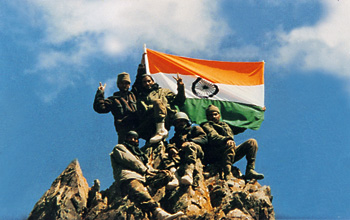INDIAN ARMED FORCES CHIEFS ON
OUR RELENTLESS AND FOCUSED PUBLISHING EFFORTS

SP Guide Publications puts forth a well compiled articulation of issues, pursuits and accomplishments of the Indian Army, over the years

I am confident that SP Guide Publications would continue to inform, inspire and influence.

My compliments to SP Guide Publications for informative and credible reportage on contemporary aerospace issues over the past six decades.
- Interim Defence Budget 2024-25 — An Analysis
- Union Defence budget 2024
- Indian Army: In quest of greater firepower and policy recommendations for gaps
- Indian Army Annual Press Conference 2024
- 6G will transform military-industrial applications
- Tata Boeing Aerospace Delivers 250 AH-64 Apache Fuselages, Manufactured in India
Another Kargil Anniversary — what did we learn?
 |
By Lt. General P.C. Katoch (Retd) Former Director General of Information Systems, Indian Army |

July 26 will be another anniversary of the Kargil Conflict, not very different from previous ones albeit few events merit mention: signature campaign on petition by father of Captain Saurabh Kalia's for GoI to take Pakistan to International Court of Justice is gathering steam; military veterans relay hunger strike at Jantar Mantar and protests pan-India for non-implementation of OROP have broken all records; MoD surrendered Rs 6000 crores on 31 March 2015 despite continued inaction on procuring bullet proof jackets for soldiers; import of assault rifles is scrapped; Rs 1000 crores earmarked for National War Memorial in last FY budget lapsed; government shows no inclination to restructure higher defence set up and MoD, to name a few. But what did we learn from the Kargli Conflict and what was the follow up? The enormity of the Kargil intrusions surprised our security establishment but we still have not invested in HUMINT in areas of our strategic interest.
On top of it we disbanded Army's Technical Support Division (TSD), raised after the Kargil Conflict that was giving excellent cross-border intelligence. Part of our military's success was because 400 Bofors guns could be cannibalized into 100 guns that pulverized enemy defensive positions. Yet, the artillery continues to face horrendous shortages. Trials of indigenous 'Dhanush' have been successful but it will take decades to fill voids. The proposal to import Howitzer guns from BAE Systems, USA appears to have been shelved while procurement of additional 130mm guns is no substitute where howitzers are needed. Our Special Forces who could have destroyed targets in enemy rear, especially gun position and main support base at Gultari, were not permitted to cross the LC. Notwithstanding the recent raid in Myanmar, a national policy to deploy Special Forces covertly at the strategic level remains elusive. Of course if the Pakistani Army had maintained surprise till the time the snows shut off both the road axis leading to Ladakh, eviction of the enemy would have been that much more difficult but what happened eventually is an open book; an emphatic military and diplomatic victory for India.
Not without reason two Pakistani Prime Ministers later acknowledged that "Kargil war was Pakistan's biggest blunder and disaster." However, considering the number of NLI battalions and SSG that Pakistan was able to deploy, all movement beyond Skardu should have been reported to the CCS by the JIC. R&AW's claim that they sent a note to the military about possible intrusions is some joke. Despite this, years later we learned about presence of some 11,000 Chinese in POK-Pakistan only through a report in the New York Times. We need to have incognito boots on ground in all areas of strategic importance to us; a culture that is grossly missing in our political and bureaucratic establishment, discounting the military that is deliberately kept away from strategic decision making. As for technical surveillance and night fighting capabilities, yes some UAVs have been inducted and we have few indigenous satellites up, but we are nowhere close to 24x7 satellite cover required. Every soldier does not have night fighting sights. Hand held surveillance devices are limited. The UGS are ineffective in snow. Induction of MAVs is inordinately delayed. Radars have been deployed in limited numbers but the Battlefield Surveillance System (BSS) under development is bogged down in red-tape.
There is even acute shortage of GPS and bullet proof jackets, while the tender for assault rifles has been scrapped. The Air Force could have literally knocked out enemy positions but laser guided weaponry was absent, and it was only towards the end of the conflict that some improvisation was resorted to target enemy logistic support echelons. Finally are the vital voids of a National Security Strategy and a Comprehensive Defence Review. Unfortunately virtually no progress has been made on these counts. The recommendations of various committees have been implemented peripherally. The military continues to be kept away from strategic decision making. The MoD continues to be run by generalist bureaucrats who are not even accountable. There are no signs the users (military) being inducted in design, planning and decision making levels of the DRDO, DPSUs and OF. The CDS is yet to be appointed without whom military synergy remains misnomer. If these issues remain addressed, we can continue to celebrate Op 'Vijay Diwas' annually and salute the Kargil martyrs without actually saluting them.





